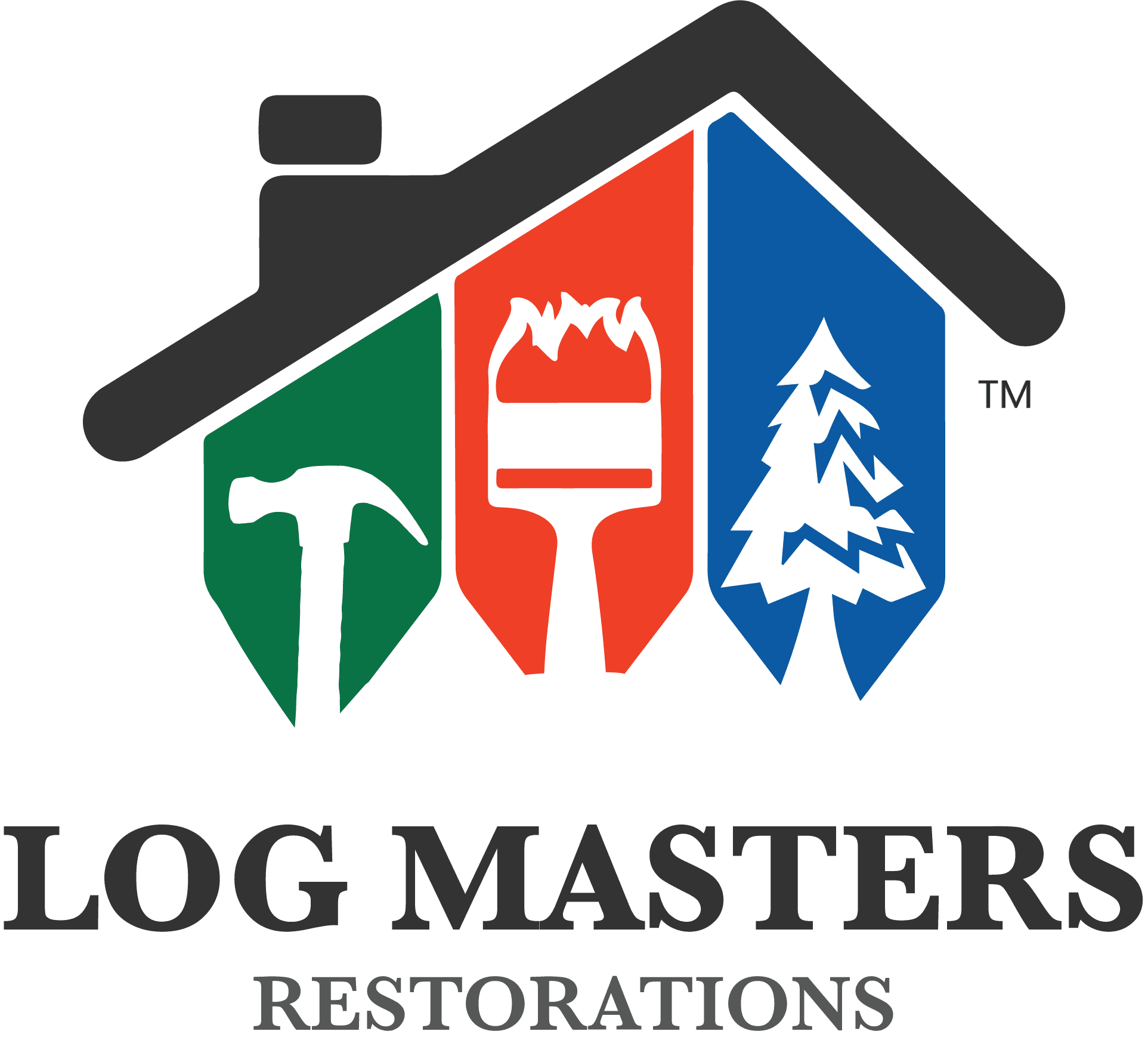You have questions, and you want answers. Typically, log homeowners have a basic knowledge of what concerns them regarding their log home. However, they may need to learn additional things that can significantly impact the restoration cost or regular maintenance. Customers often need clarification on what information we need from them for a free online estimated cost to restore or maintain their log home. The simple answer is on our Checklist blog.
Free online estimates without visiting the log cabin?
You may need help understanding how we can create a free online estimate without visiting your home. If so, please check out our article Free Online Estimates Versus In-Person Assessment.
Why do you want that?
However, you may be the kind of customer who likes to understand the reasons behind our requests, what factors we consider when making an estimate, and why. Some customers do not know why we need the information we need. If you read on, we can explain some of our most common information requests and why we ask for them.
In this Article
In this article, we’ll talk about the regular requests we make of our potential customers and let you know the various factors that impact the cost when creating a free online estimated cost and why. To understand, click on the underlined item you wish to read:
Once you have read this article, we hope you will feel like we have provided you with some valuable education and transparency into the factors surrounding your estimate. This is a detailed explanation, so at any time, you may navigate back to the list above by clicking 📃 at the end of each section.
Normally Requested Information
General Location
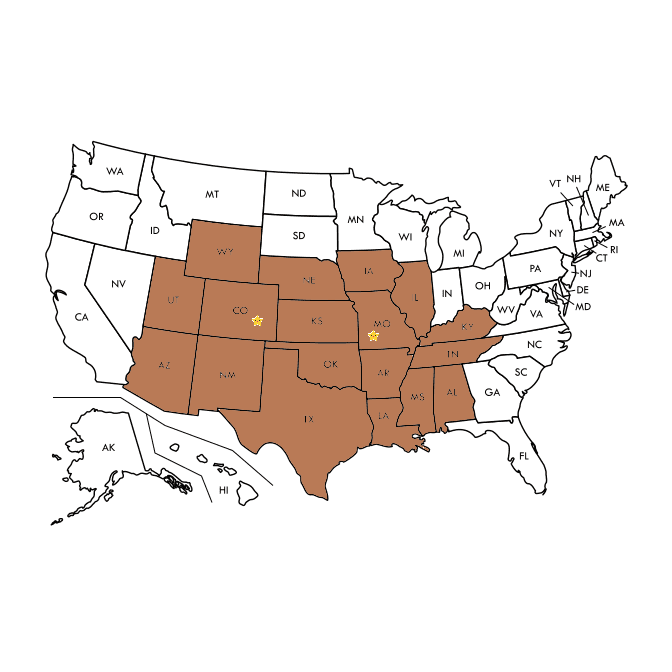
Now, this seems obvious, and often potential customers will tell us their address. This is generally told to us so they can determine if we service their area. We have proudly served log home owners in Missouri, Arkansas, Oklahoma, Louisiana, Alabama, Mississippi, Tennessee, Kentucky, Illinois, Iowa, Nebraska, Kansas, Texas, Colorado, Utah, Wyoming, Arizona, and New Mexico. This is a unique list since we have traveled to other areas near the adjoining states we serve. For example, southern areas of Wisconsin or western areas of Indiana, but not necessarily the state of Wisconsin or Indiana. This may save you a step if you are away from one of these states or nearby areas. 📃
Our Locations
Our base of operations is in Springfield, Missouri, and Westcliffe, Colorado. We had a branch office in downtown Colorado Springs, Colorado that we started in November 2020 until August 2022 before moving to Walsenburg, Colorado, in 2022. In April of 2023, we moved our Colorado branch to its new permanent location in Westcliffe, Colorado. We gladly take questions from anyone in any state. However, as we are a service company that meets our customers where they live, finding us in the office is rare. Please request an appointment if you’d like to meet with us at one of our two locations. 📃
Currently, with the COVID restrictions and the increasing cost of fuel, we have implemented online meetings through Google Hangout, Zoom, Microsoft Teams, etc.

Your Address
While potential customers freely offer the city and state to verify our ability to assist them, occasionally, they need to include the physical location or address. Perhaps this is out of fear, as I mentioned earlier. Fear of letting others know where their precious gem is hidden. They need to realize how their location can impact the cost of their estimate.
Many owners of timber houses are in the countryside, nestled in a forest of trees and seclusion. We can appreciate the decision to keep the whereabouts of their log cabin or home private. Especially since many of them are second homes or off the grid. The reason we ask for your address is twofold. 📃
Google Maps

Firstly, we use your address in Google Maps to get an aerial image of the location and home footprint. This helps us determine the square footage of your log cabin and see if there are any obstacles near your log home or to your log home.
Aerial View Shows Obstacles
For instance, say your log home is high in the mountains, and the only way to it is up a winding dirt road that hugs the mountainside. This could impact our ability to transport heavy equipment. OR your log home is beside or over a lake or river, which will impact our products. These are just a few factors we consider when restoring or maintaining your log home. 📃
Street View
And secondly, we also use your address to take a street view look to get a picture of your log home. This can tell us what challenges to scaffolding and ladders we may need to consider. While not all log homes have a street view online, some can be found on other websites like Zillow if the log home was sold at some point. 📃
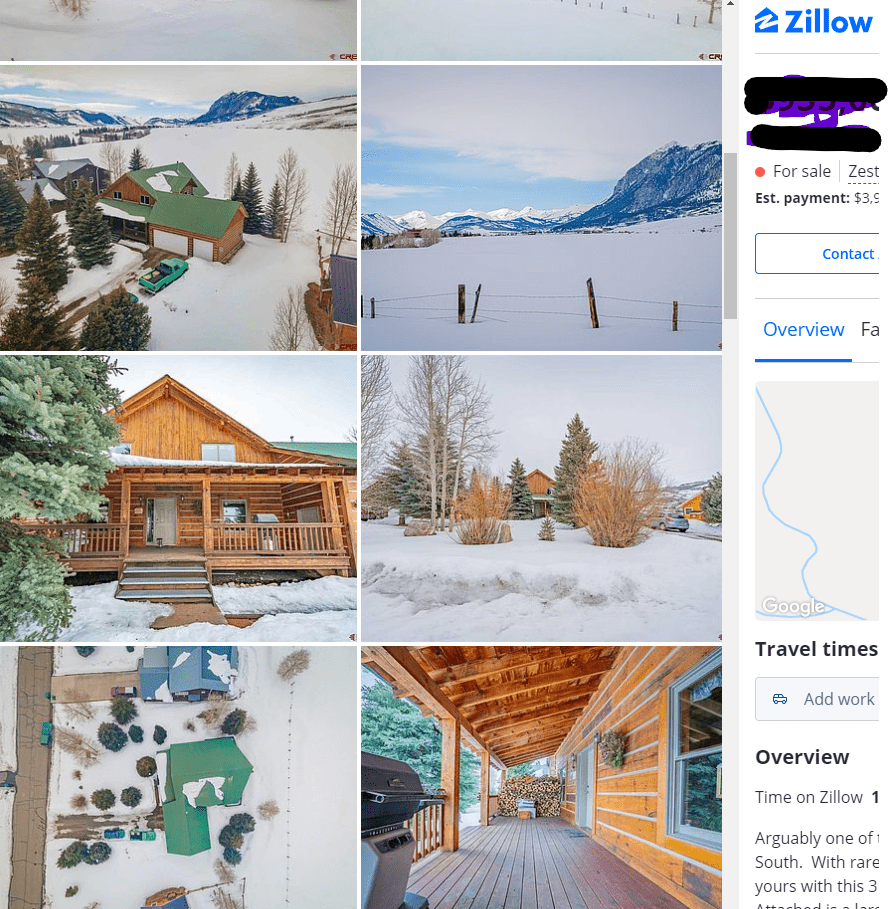
Service Comes to You
And finally, the location can impact the cost. Since our service comes to you, it may be further than an hour from our two bases of operation. In most cases, with all log home restoration companies, crews must travel and stay near the location until the service is completed. This helps us maximize our daily time spent restoring your cabin instead of paying it on drive time, which adds up and takes away from our daily hours spent restoring your home. We like to keep crews within a 30-minute drive if the customer’s residence is an hour from Westcliffe, Colorado, or Springfield, Missouri.
Hotel Costs
If travel is necessary, we have to consider the cost of available hotels for our crews to stay and the local amenities available. If your home is very remote, is over an hour from the nearest town, and is in an area with high hotel prices, this impacts the service cost. Also, gas prices can impact the cost as they rise and fall. 📃
We avoid these being a primary consideration unless there is a significant increase in gas and hotel prices, as we have observed recently. Inflation in the economy can significantly impact the overall cost of labor.
“A picture is worth a thousand words.”
If you are still uncomfortable giving out the physical location, it is not a significant issue. Instead, we ask you to provide the square footage of your log home, detailed information about the size and obstacles to overcome, and multiple picture angles of the entire log home from the outside. This will then be a preliminary estimate, but a precise estimate may be needed.
This could not be truer, as we touched on above. We have created a general list of suggested pictures to help you communicate information about your log cabin needs and details to guide our staff during the estimation process. 📃
List of Suggested Picture
We have compiled this list to help you effectively communicate the needs of your log home. This is a general list of all things to consider including. It’s only a suggestion to get you started. As a helpful guide, we suggest you take pictures of:
- Environmental obstacles such as:
- a house over a lake or water,
- Road access problems,
- Power lines attached to the log cabin.
- Around your window and door frames, look for rot or insect issues.
- Facia and nearby logs (only if the facia is less than a foot from the log siding or has issues)
- Logs near the ground (especially if the log height above the ground is below a foot)
- Areas of regular shade (often you will see a green hue on these logs)
- West and south facing walls get the most rain; however, east and north facing walls can struggle to dry out, so don’t overlook them
- Decks if you have one you want us to include in our estimate
- Posts or columns on the front or back porches
- Chinking cracks or finish cracking/bubbling or weathered (click on either for more info)
- Look for extended horizontal cracks/checks in the logs creating troughs for rain to be held; typically on the top of a log-checks that allow water to flow out are not of significant concern.
- Signs of insects.
- Question areas that might need an expert eye.
Taking Pictures
You can use your phone or camera to email or text pictures to us. Just send them to [email protected]. If you need to text images to us, please get in touch with our office. We will want pictures from all sides of your home. Make sure you get in close on areas of concern. No one likes to get a change order on an estimate because they didn’t include enough pictures to get an accurate estimate. 📃
Precise Pictures
Please do the following to ensure you have included good, specific pictures. Using a ruler, tape measure, quarter, or soda can provide perspective by including them in the picture. We ask that you take pictures of all the areas of concern, including potential log rot, insect damage, caulk or chink lines separating, and cracked or missing finishes. If you need clarification, please call us to schedule an appointment or discuss it. 📃
Things Impacting the Cost of Restoration or Maintenance
As we discussed earlier, several contributing factors can affect the restoration cost or regular maintenance. These are the extra little things that often get overlooked by homeowners. In this section, we intend to educate you on the types of logs, caulk, and chink, checking for log rot and insects, and issues with clear finishes. We also want to explain how these factors can vary the estimates one log homeowner receives from another. 📃
Fact: As of November 2020, the price of lumber has doubled and has not gone down but is progressively getting more expensive. In 2024, the price has gone down slightly. This is why the cost of building has increased, and homeowners can sell their homes for double their loan. Also, since February 2021, labor costs/hourly wages have increased as Biden’s initiative toward increased equity impacts businesses nationwide. The continued rise in gas prices since the summer of 2022 greatly affects the cost of the restorations and materials nationwide.. 📃
Types of Log Home Exteriors
What makes a log home a log home? The exterior and interior? Is it based on appearance or structural makeup? Depending upon who you ask, opinions on what qualifies as a log home vary. Big or small, the fact is there are two types: Log Sided Homes and Log Cabin Styles.
Log Sided Homes
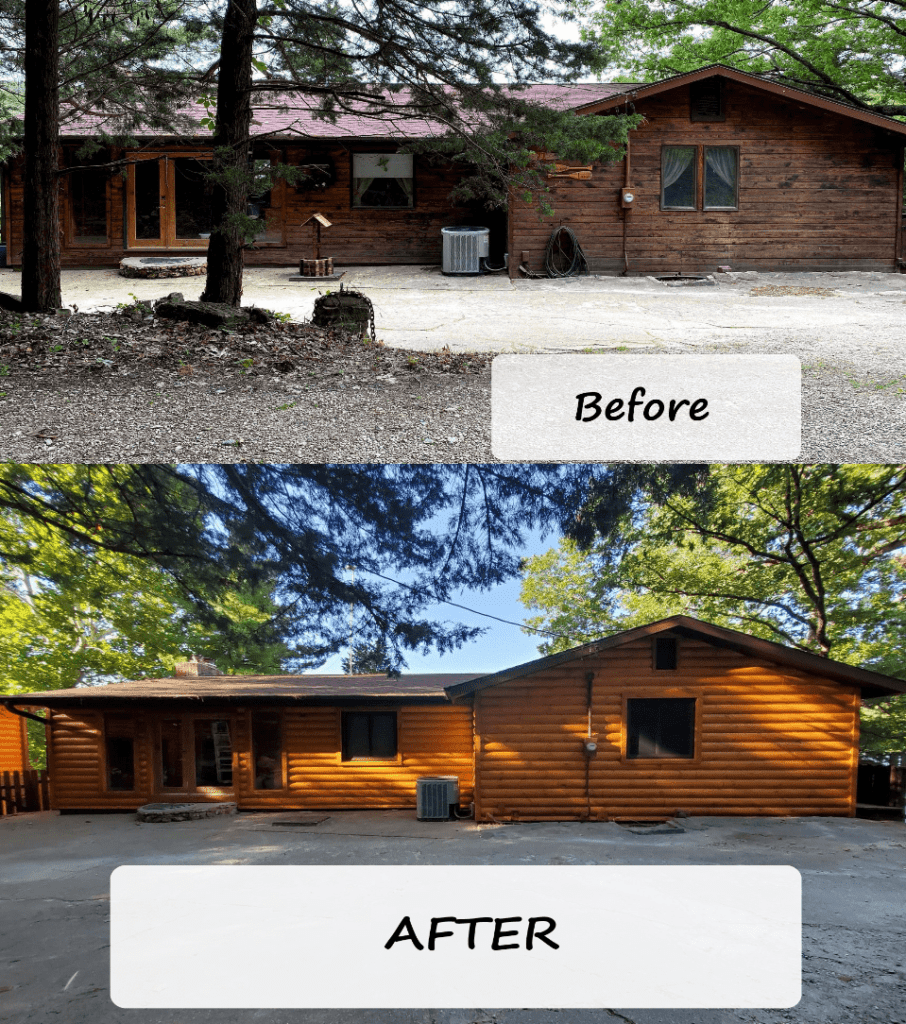
Log home exteriors vary from logs to log siding. Log-sided homes can look just as beautiful as a log cabin. Read “Log Home Look to Fit Your Budget” to learn about log home siding. Homeowners can check with their local city or county building and zoning to discover the exterior composition.
Log Cabin Styles
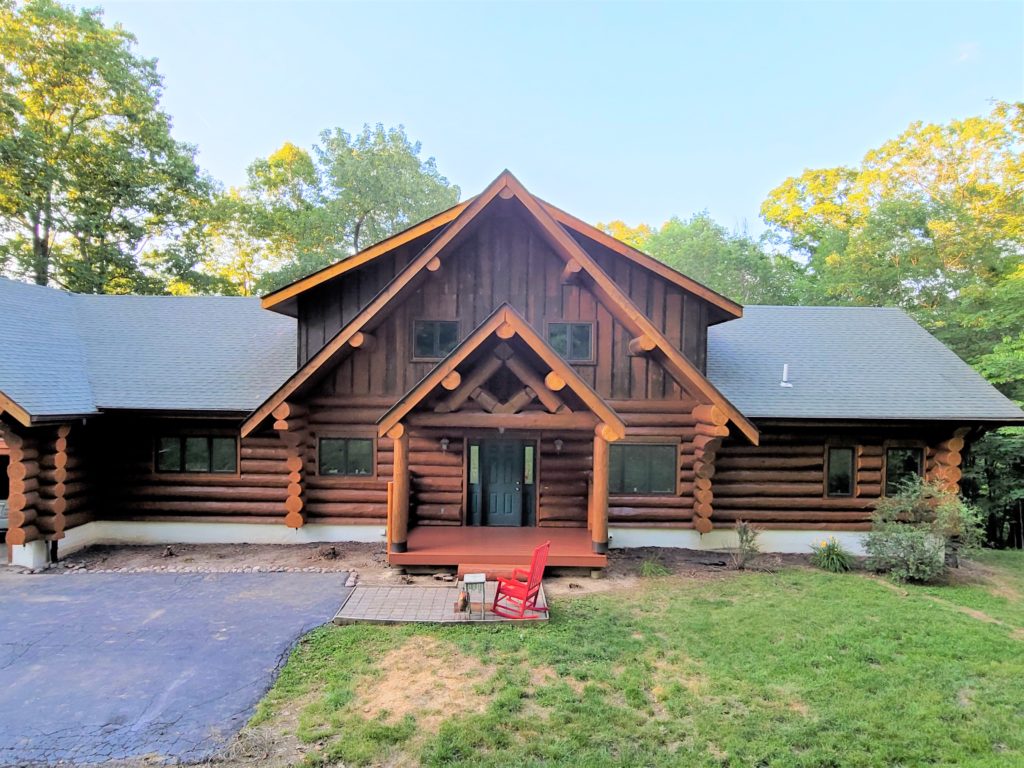
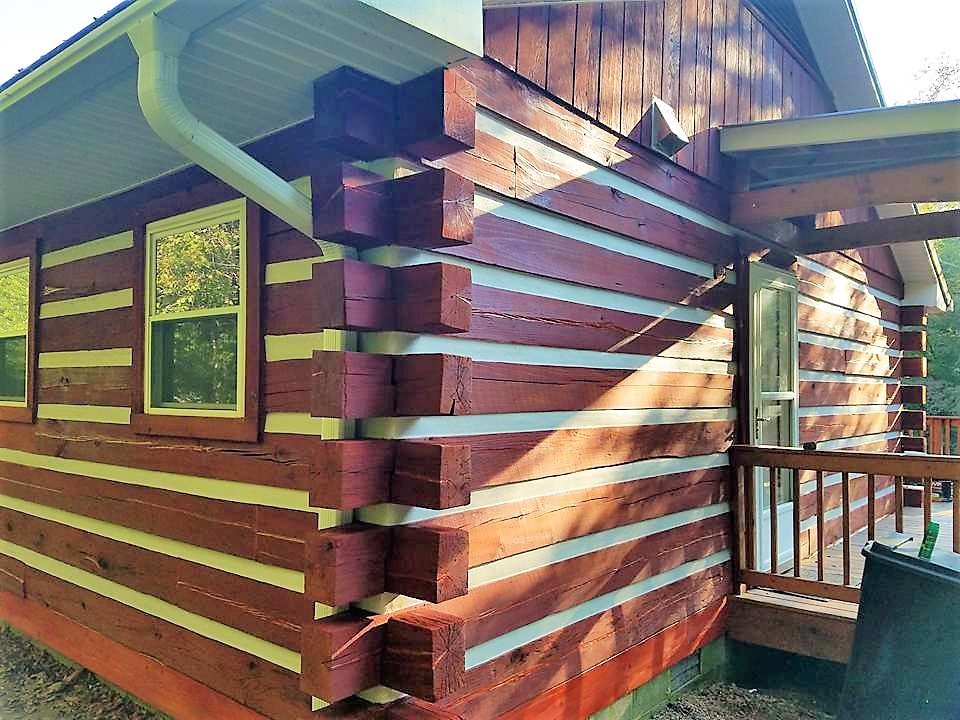
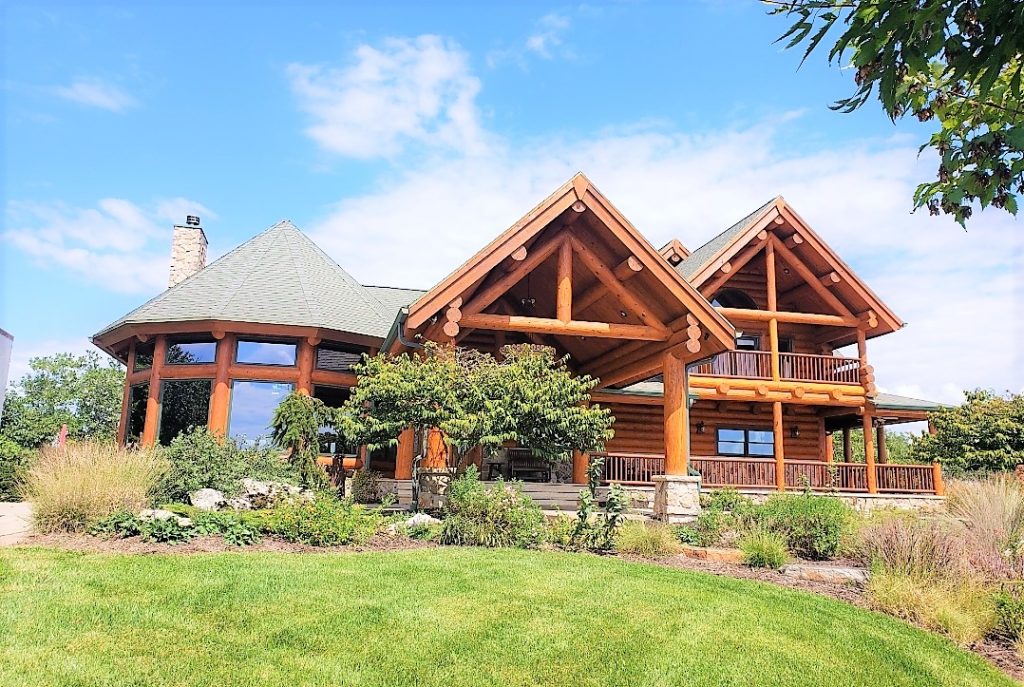
There are a variety of log cabin styles. This often is based on personal preference and functionality. Log species, such as fir and cedar, have a variety of styles and prices. Specialty joints, log styles and species can impact the various restoration and maintenance costs for the same size structure.

Knowing your type of log style is generally easy to tell from pictures. However, your home may have multiple kinds of logs or styles of logs and log siding or a combination. It is not unheard of to discover part of the cabin was made with Douglas fir logs in a specific style and an addition to the home done in cedar logs of a different style and log siding around the foundation.
Additional Styles of Logs
Log styles go a step further when considering the exterior log surface, joints, corners, and ends. Each of these also contributes to factors drastically impacting the time needed to fix log rot in a given area. Some log rot is only a foot or two in length. To save money, rather than order a complete log in that style, a skilled log master may cut/mill another log on the site. For more information on log styles, visit our article “Different Log Styles to Choose From for Your Log Home Build.”
Once you have discovered or decided on the log species, these prices can make the estimate higher or lower. 📃
Chink and Caulk

Log homes typically use caulk or chink between the logs as a barrier from the elements and to protect the logs from water damage. The main difference between the two is elasticity and texture. Chink is more commonly used for large gaps between logs and is sometimes two inches wide, while caulk is used for smaller or tight gaps. 📃
History of Chink
Historically, chinking has been used by log home builders for centuries, dating back to before the birth of Christ. Chink was typically made with nearby materials to pack the space between the logs. It could consist of moss, dung, hay, clay, sand, gravel, and other natural resources nearby. You will often hear it called mortar if it is like concrete. 📃
Mortar Chink
Mortar chinking is a concrete-like substance that is generally cheaper and around 10% of the price of synthetic chinking. The mortar can crack and break down as the house settles, allowing moisture between the logs. And we know moisture trapped in logs spells log rot down the road. While mortar chinking is inexpensive, removing old mortar and any log rot discovered can increase the cost of removal. Chinking needs more flexibility to withstand the seasons. You will save money overall with the new synthetic chinking. 📃
Synthetic Chink
Nowadays, chink is made from synthetic material to allow for more elasticity to combat the seasons when the logs shrink and expand. Whether your home needs chinking depends a lot on the style of the home. Some homeowners like the look of chink lines, and having them installed when caulking would be sufficient. Chinking a home can extend the cost and time of a restoration. 📃
Caulk
Caulk is almost always used around windows and doors or small tight joints on log homes. It has a higher elasticity than chink but often lacks textures. Likewise, it comes in a few colors to match the stain, chink, making it nearly invisible to the naked eye. It is also much easier to apply than chinking, meaning less time spent restoring your home. Less time often equals lower costs. 📃
Log Rot and Insects Signs
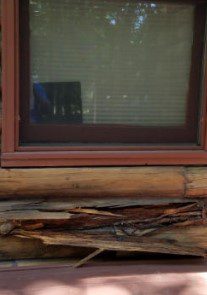
Most potential customers are calling us for a restoration estimate. This is because they have noticed some areas of concern. Both log rot and insect infestation can cause extreme damage and represent the bulk of the estimated costs. Perhaps you see log rot or insect signs. In this section, we will lightly go over both. 📃
Log Rot
Log rot, which I covered in a previous article, “Types of Log Rot,” is at the top of most log cabin homeowners’ concerns. You may have noticed black behind the finish or chunky pieces falling away. These could be signs of log rot or a poor finish. 📃
Insect Signs
Coming in a close second to log rot is insect damage or infestation. Both are valid concerns as they are the top two reasons log homes need restoration. Please don’t panic. Log rot and insect damage can be repaired and avoided. 📃
Often, the reason logs rot and insect damage occurs is due to the homeowner’s inability to keep up with regular maintenance, or they did not heed the recommended care instructions of the log home builder. Before you can tackle avoiding both, you must discover your current situation. Please know how to check for signs of both. If you’d like to know how to check, read our article Checking for Log Rot and Insect Infestation. 📃
Past Restorations Not Done By Professionals
Restorations that have not been done by a professional can cost you BIG $$$$$$! I know it is so tempting to hire your self-employed buddy whom does construction work to do the labor of restoring your log home…but I would definitely caution you against this action. You might be thinking, “He’s cheaper and I like keeping my money local,” or “That’s because they want our money.” Of course, we are a business and you being a potential customer makes those partially true but not the reason why I caution you. In this portion of this article, we will help you understand the importance of hiring a skilled Log Master. 📃
Experience Matters
While construction or carpentry experience is a background we look for when hiring Log Master’s Apprentices, it is not the only experience needed to restore log cabins. Carpentry is a great skill set with a lot of value. Probably any good carpenter could learn how to restore a log cabin with time and education.
“Oh. I can figure it out,” brush off we hear from people is not a good sign. They might figure out the details but may not understand the bigger picture.
LOG HOMEOWNER AWARENESS: When we hear this, it all too often results in a higher estimate when you call back. This is often due to the fact that additional issues have been created by the attempt to do it themselves, resulting in more for us to fix than the original estimate included. Just something to consider when trying to do it yourself.
Carpenters and Log Masters vary in experience. Our apprentices, journeymen and masters have seen multiple cabins with a variety of issues and repairs. Our trained employees know what products and tools to use and how to use them to be most efficient and effective. They know how to recognize details and issues that can be overlooked. Also, they know what NOT to do, which is very important when working on your dwelling. Without going into too much detail regarding our training, what you need to KNOW is why I caution you. 📃
Cheap is NOT Always Best
Of course, we all know that cheap is not always best. Usually, it’s what we can afford. It would be nice if we could all afford the best. Nevertheless, you would not go to any doctor when you need surgery to remove cancer. You go to the doctors who specialize in cancer removal. Likewise, you don’t go to any carpenter when it comes to fixing your log cabin.
We have had customers call us after having someone else “restore” their log home. Sometimes, in the middle of a restoration as well. This is due to the fact that even the customer is loosing confidence in the work being accomplished since they, too, know how to google search log home repair tutorials. The point I am attempting to get to is this. You spend money with the cheapest and you get what you paid for… and then some. 📃
And Then Some
The “and then some” is typically due to the damage they have caused and how bad it looks when the “cheaper guy” is done. Sometimes, it means more time will have to be spent than originally to repair the “repairs” the inexperienced guy did. 📃
Bad Restoration Example
For example, one of our customers paid for a local guy to restore his cabin. When we got to the cabin, you could instantly see why the customer had called us. The customer’s budget had been spent on most of the right products but the application was unsightly and really bad. Not only was it applied wrong, it had made things worse by masking issues that needed repair. Log rot had been covered up by a thick coat of stain and finish and had spread to several neighboring logs. This meant he had wasted his budget and was now going to have to spend more money to just get it descent. Here is the video from that customer’s restoration.
If you don’t want to end up spending twice the amount to repair your log home, don’t call just any guy. Call a professional. 📃
Issues with Clear Finishes
I bring this up since some customers have chosen in the past to skip the stain and only use a clear finish to protect their logs. Yes. The natural wood is so beautiful and bright caramel in color. Their home…their choice. As a professional, we would not do this. This can cause some problems for the logs since it is not recommended to use a clear finish in substitute or in lack of a stain. There are stains that bring out the natural color and protect the logs. 📃
I explain some of this in my article “Can I Use a Clear Finish Instead of a Stain on My Log Home”. Issues with clear finishes on a log home often are recognized by:
- cloudy clear coat over the logs
- many white dried drips on the surface of the log
- less than clear transparency over the stain
- black spots or patches
- cracks
- pealing
- bubbles
Cause for Poor Finish
As far as a finish with issues, the causes can range from a poor application of too much or too little clear coat. Perhaps even the wrong kind of clear coat. Clear finishes without pigment [see Perma-Chink’s Article “Why Log Homes Need Pigmented Finishes“] can result in issues down the road.
Other finish issues include sun damage or natural aging and scratches from nearby bushes or trees. This is why most experts in the log home industry recommend keeping shrubs away from the home. Admittedly, clear coats generally need reapplied in the best conditions between 5-7 years and 2-3 years in worst conditions such as south facing walls or high sun. This is why it is vital to your log home to have regular scheduled maintenance. 📃
Maintenance
Unfortunately, you may have overlooked the recommended maintenance plan for your log home building or purchased one you can tell the previous owner didn’t keep. Regular maintenance is essential to avoiding costly restorations. Your regular maintenance, or lack thereof, can drastically change the necessary repairs needed and cost for repair.
Log rot can be avoided but often occurs because the homeowner was unable to keep up with regular maintenance or didn’t heed the recommended care instructions of the log home builder.
Most homes with good stains and finishes in humid climates need regular maintenance every 2-3 years, while arid climates need it every 4-5 years.
Log homeowners should understand that their home is not maintenance free and there is a continuous expectation over the life of their log home to stay on top of regular maintenance. As mentioned above, you can avoid problems by speaking to log home professionals and asking for advice on ways to lengthen the stain and clear finish longevity. 📃
Admittedly, there are some things you cannot control such as:
- wind blowing sand and debris against the side of your log home
- rainy seasons which increase the normal humidity
- cold which causes expansion and contraction
- heat which can scorch
- natural disasters such as tornados, earthquakes or hurricanes which bring all kinds of issues
- animal rubs or scratching on your log home
If you cannot afford regular maintenance, then do your research and follow the maintenance instructions for your stain, finish, and/or cabin. Maintenance is the key to avoiding costly restorations in the future. 📃
Certified Log Home Inspectors
If you are ever unsure, contact a log home inspector by going to InterNACHI. There you will find certified log home inspectors that can give you valuable insight on the condition of your log home. Of course, you are always welcome to give us a call 719-657-7277 or email us at [email protected] with any questions or concerns you have. 📃
